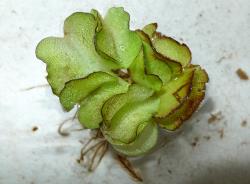Aquatic ferns, free-floating. Stems short, branching, hairy, lacking roots. Leaves dimorphic, arranged in whorls of 3; each group comprising two floating, green, entire, foliar leaves, and one submerged, highly divided leaf appearing root-like; upper surface of foliar leaves bearing specialised water-repellent hairs; lower surface of foliar leaves and the submerged leaves bearing multicellular hairs. Veins anastomosing without free included veinlets. Sporocarps attached to the submerged leaves, subsessile or stalked, globose to ovoid; each sporocarp bearing either mega- or microsporangia. Sporangia usually empty in NZ plants; when fertile (not NZ), megaspores solitary in each megasporangium; microspores 32–64 in each microsporangium. Spores absent or aborted in NZ plants; when formed (not NZ) megaspores spheroidal, plain, perforate; microspores spheroidal, plain to rugulate.
10–12 species widespread in tropical regions, extending also into temperate areas, with two centres of distribution in Africa, and in South and Central America (Schneller 1990); some species have become tropical weeds. One naturalised species in New Zealand.
| Category | Number |
|---|---|
| Exotic: Fully Naturalised | 1 |
| Total | 1 |
x = 9 (Schneller 1990), the lowest base chromosome number known in ferns (Smith et al. 2006).
The taxonomy of neotropical species was outlined by Mitchell & Thomas (1972) and adopted by Tryon & Tryon (1982). Following the initial investigation, Salvinia ×molesta was described as a new species (Mitchell 1972). It belongs to a small group of South American taxa, including S. auriculata and S. biloba (syn. S. herzogii, see de la Sota 1995), in which the hairs at the end of the leaf papillae are joined at their distal ends.
Based on analysis of five different genes, Nagalingum et al. (2008) showed that Salvinia comprises two Eurasian and American groups, although only the American clade, which includes S. ×molesta, is strongly supported.
Plants of Salvinia are free-floating and capable of covering large areas of slow-moving or still water. In New Zealand, sporocarps are rare and are usually empty when found, and reproduction is vegetative. Spores of American species are illustrated by Tryon & Lugardon (1991).




